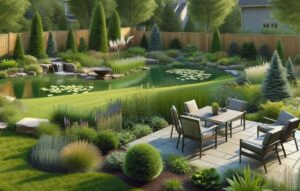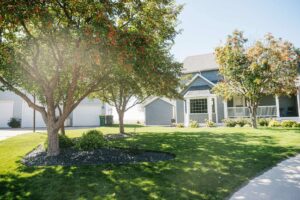Switch to native plantsBeyond increasing property value, making eco-friendly property upgrades offers numerous benefits, including increasing your home’s curb appeal, improving quality of life, and more importantly, protecting the environment.
Before digging into the different kinds of upgrades you can adopt, let’s first define what sustainable landscaping is.
Sustainable landscaping is an umbrella term for the design and construction of outdoor spaces, such that it is optimized to conserve and protect natural resources or elements.
Additionally, these designs offer tremendous ecological benefits and reduce the labor and time required to maintain outdoor spaces.
Examples of eco-friendly upgrades you can embrace include installing or using permeable hardscapes, native plants, retaining walls, rain gardens, green or cool roofs, energy-efficient lighting, compost bins, and much more.
In this article, we expound on these upgrades to see what they are, how they work, and their benefits.
1. Permeable Hardscapes
Permeable hardscapes are a sustainable substitute for traditional concrete. Rather than water flowing over them into the sewer, water seeps into the ground unimpeded.
Installing a permeable hardscape can improve the sustainability of your home, especially concerning stormwater management. These types of hardscapes serve two primary stormwater purposes.
They reduce the burden on the municipal stormwater systems and limit the amount of pollution fed into local waterways, where the toxins and pollutants may destroy the natural ecology of the water bodies.
Additionally, permeable hardscapes help to recharge the groundwater soil and aquifers. In simpler terms, the water keeps your home garden hydrated and conducive to life and a healthy ecosystem.
Some jurisdictions encourage using permeable hardscapes by offering free credits or grants to reduce costs. So, you may want to check your local land management departments.
2. Switch to native plants
Native plants require less maintenance and are more favorable for local wildlife populations than non-native options.
For example, you’ll need to provide regular human intervention when you import a plant that thrives in a rainy region to a dry one.
This is because the non-native plant is not used to local climate, soil, and weather conditions, thus requiring more resources.
Such plants will likely need more chemical fertilizers and supplemental watering or irrigation to survive.
But reverse is the case for native plants because they preserve the local biodiversity. For these reasons, native healthy plants are preferable and inherently better for a sustainable landscape.
While sourcing for native plants and accessories, ensure you get pest-free plant materials so you’re not starting your garden on the wrong foot.

3. Erosion Control with Retaining Walls and Organic Materials
North Dakota is extremely prone to erosion, whether by rain or wind. Consequently, there are only a few inches of nutrient-rich topsoil left in the Red River Valley. That’s why taking preventive measures against erosion is a sustainable sites initiative you can take.
You can stop erosion by installing concrete or timber retaining walls. Alternatively, you can opt for a more natural method by planting trees or shrubs with shallow root systems or using organic mulch.
These organic elements will attract pollinators and equally help prevent soil erosion.
4. Add a Compost Bin and Make Your Own Fertilizer
Did you know that food waste (21.6%) and yard trimmings (12.1%) are the fourth and fifth largest sources of waste generated in the United States?
Composting will help you manage these waste materials more sustainably. It requires minimal time and effort and can be a fun pastime.
You help reduce the amount of refuse that would have otherwise found its way to landfills or trash incinerators, which lowers the amount of greenhouse gasses emitted into the atmosphere.
Additionally, you can save money by creating free and high-quality soil nutrients, lowering your dependence on fertilizers and even pesticides.
Other uses of compost include water conservation, soil erosion prevention, and improving plant growth in your garden.
The following wastes are particularly best for composting:
- Grass clippings
- Food and vegetable scraps
- Yard waste
- Eggshells
- Plant stalks and twigs
- Wood chips (untreated)
You can find a comprehensive list of what you can and cannot compost from the Environmental Protection Agency (EPA).
5. Create a Rain Garden
A rain garden is a sustainable landscape design that carefully channels water to different zones.
Rain gardens offer similar benefits to permeable hardscapes in that they prevent stormwater runoff of oily and polluted water into the storm drain and then into a stream, river, or bay.
A rain garden typically has three zones. The first zone is the outermost part and caters to plants that thrive in drier conditions. The plants in the second zone can only tolerate occasional stagnant water.
The last zone is the innermost zone, where most of the water drains into. This zone is for plants that flourish in wetter conditions.
The key to creating a perfect rain garden is proper plant selection. It’s imperative to choose the right plants for each zone for the rain garden to flourish.
6. Sustainable Landscape Rock Gardens
Rock gardens are relatively low maintenance, which makes them a great candidate for your sustainability efforts. They add both aesthetic and functional quality to any space.
Some of the many benefits of having a rock garden include:
- Weed control – the rocks stifle weed growth, leaving room only for cultivated plants. Rock gardens may limit the presence of plant pests, too.
- Rock gardens can survive anywhere, including the four distinct seasons of North Dakota.
- Helps conserve water – Rock gardens may require minimal watering if you use plants like cacti.
- You can diversify your garden by adding different sizes of rocks, including pebbles, boulders, and large stones. This creates an outdoor space with both depth and character.

7. Install Energy-efficient Landscape Lighting
Whether indoors or outdoors, energy-efficient lighting can save you hundreds of dollars per year.
According to the Department of Energy, switching to light-emitting diodes (LED) can save you $225 in energy costs per year, on average.
You may save more depending on the size of your property and if you use the bulbs with an “ENERGY STAR” rating.
For extra savings, you may add timers to automatically turn off the lights when not in use or add dimmers to reduce the intensity coming from the bulbs.
Especially for outdoor lighting, consider those with features like automatic daylight shut-off and perhaps motion sensors.
8. Use Recycled, Repurposed, and Reclaimed Materials
Reclaimed concrete and other building materials may offer the same value as some never-used materials. You’ll be saving some money and stopping a big chunk of waste headed to landfills.
You can use recycled construction materials to build landscaping elements like garden walls and fire pits. You can also use repurposed wood for patios, decks, and raised flower beds.
The only precaution you should take when working with reclaimed or repurposed wood is to ensure they’ve not been treated with toxic chemicals that harm the environment because that defeats the entire purpose of your project.

9. Upgrade wood decking or porches with composite product
Upgrading your deck with composite products made from recycled materials has many long-term benefits. Your shift is supporting less felling of trees on top of being recycled, which are both helpful for the environment.
First off, conventional decks require finishing after installation to protect them from damage. This is not the case with composite materials due to the plastic coating. You don’t also have to worry about doing regular maintenance to prevent rotting, splintering, staining, or fading.
Secondly, composite decks do not suffer mold and mildew growth, unlike hardwood. Another advantage of composite products is uniform hardness, which is hard to experience, even when you buy all your wood from the same manufacturer.
10. Switch to Renewable Power Sources
Landscaping requires watering, lighting, mowing, blowing, and general maintenance, all of which consume a significant amount of energy.
Switching to renewable power sources transitions you off of traditional sources like fossil fuels that degrade the environment.
The most obvious option in this regard is solar. Even as much as switching only lighting to solar-powered fixtures is a step in the right direction.
Renewable power sources reduce the carbon footprint of your property. You may also be eligible for local and federal tax credits and incentives.
While the initial setup cost may be unattractive, the setup more than pays for itself over the long run. Moreover, the cost of installing solar panels continues to drop – dropping 40% between 2012 and 2022.
11. Install Faucet Aerators
Gardening requires a lot of water. Most faucets have a standard flow of about 2.2 gallons per minute. An aerator reduces this flow to 1.5 gallons per minute without impacting performance. You will still be able to water the plants normally, and may even help to prevent overwatering.
When you upgrade indoor taps, you may be saving upwards of 700 gallons of water per year. Another consequence of using less water is you’ll use less water heating, which can also add up to your cost savings.
Per the EPA, “If every home in the United States replaced existing faucets and aerators with WaterSense labeled models, we could save nearly $1.3 billion in water and energy costs and 69 billion gallons of water across the country annually.”

12. Convert Grass to Meadow
A meadow is an uncultivated area featuring mostly wildflowers and shade trees. The area would also require very little water throughout the year, making them great for conserving water.
Converting your turn or grass lawn to a meadow may seem weird, especially if you’re an esthetics-first person. But consider some of the many benefits of making this transition:
- Meadows are more effective at preventing flooding and can help mop up pollutants like fertilizers, pesticides, and herbicides.
- Meadows does not lose water to the atmosphere like turn lawns. Turn lawns require massive amounts of water to stay green throughout the year, most of which is lost to evaporation or runoff.
- Meadows increase the area’s biodiversity, as they attract different kinds of wildlife because of the number and types of plant species.
- Reduces the use of lawnmowers and other equipment. That’s less pollution from when the machine is in use and reduced dependence on gasoline. Your pocket wins, and the environment, too.
Takeaway: Increase Home Value While Saving the Planet! Win-win!
In a world that’s increasingly eco-conscious, upgrading your property with sustainable landscaping isn’t just a passing trend; it’s a necessity.
This article lays out 15 easy, eco-friendly property upgrades that not only boost your home’s value but also do wonders for the environment.
From permeable hardscapes and native plants to rain gardens and energy-efficient lighting, it’s a roadmap to a greener, more sustainable home.
Cityscapes Landscaping can be your partner in the journey to a more beautiful and eco-friendly outdoor space that’s good for you and the planet.
So, why wait? Let’s make your sustainable landscaping dreams a reality with landscaping and outdoor living services that fit your style, needs, and budget.



